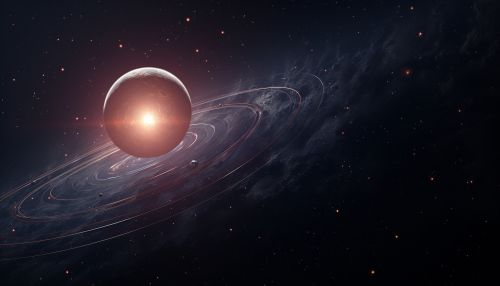Orbit (astronomy)
Introduction
In astronomy, an orbit refers to the gravitationally curved trajectory of an object, such as the path of a planet around a star or a natural satellite around a planet. The term "orbit" is derived from the Latin word "orbita", which means a track or course. The concept of an orbit is a central theme in celestial mechanics, the study of the motions of celestial bodies and the forces that act upon them.
Physics of Orbits
Orbits in the universe are governed by the principles of classical mechanics, particularly Newton's law of universal gravitation. According to this law, every particle of matter in the universe attracts every other particle with a force that is directly proportional to the product of their masses and inversely proportional to the square of the distance between their centers.


This force causes the two bodies to move towards each other, but because they also have tangential velocities, they continue to move past each other. This results in a curved path, or an orbit. The shape of the orbit depends on the initial velocity of the object and the mass of the object it is orbiting.
Types of Orbits
There are several types of orbits, each with unique characteristics. These include circular orbits, elliptical orbits, parabolic orbits, and hyperbolic orbits.
Circular Orbits
A circular orbit is an orbit with a constant distance between the orbiting object and the object being orbited. This type of orbit is an idealization, as real orbits are not perfectly circular due to factors such as gravitational perturbations and atmospheric drag.
Elliptical Orbits
An elliptical orbit is an orbit with an elliptical shape. In an elliptical orbit, the object being orbited is located at one of the two foci of the ellipse. The point of the orbit closest to the object being orbited is called the periapsis, and the point furthest away is the apoapsis.
Parabolic and Hyperbolic Orbits
Parabolic and hyperbolic orbits are orbits with enough energy to escape the gravitational pull of the object being orbited. A parabolic orbit has just enough energy to escape, while a hyperbolic orbit has more than enough energy.
Stability of Orbits
The stability of an orbit depends on factors such as the mass of the two bodies, the distance between them, and their relative velocities. In a stable orbit, the orbiting object remains in orbit indefinitely, unless acted upon by an external force. In an unstable orbit, small perturbations can cause the orbiting object to deviate from its orbit and potentially escape or crash into the object it is orbiting.
Orbital Elements
The state of an orbit can be described by six orbital elements:
1. Semi-major axis: The semi-major axis is half the longest diameter of the ellipse that describes the orbit. 2. Eccentricity: The eccentricity is a measure of how much the orbit deviates from a perfect circle. 3. Inclination: The inclination is the angle between the plane of the orbit and a reference plane. 4. Longitude of the ascending node: This is the angle from a reference direction to the direction of the ascending node, where the orbiting object passes from below the plane of reference to above it. 5. Argument of periapsis: This is the angle from the ascending node to the periapsis, measured in the plane of the orbit. 6. True anomaly: The true anomaly is the angle from the periapsis to the current position of the orbiting object, measured in the plane of the orbit.
Orbital Mechanics
Orbital mechanics is the application of the laws of physics to the motion of celestial bodies in orbit. This field of study includes topics such as orbital maneuvers, orbit determination, and space navigation.
